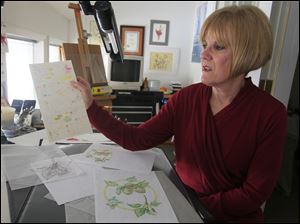
TOLEDO MAGAZINE
Botanical illustrations -- where art meets science
2/18/2013

An illustration of an oriental lily by David Herzig.

Deborah Kopka in her Perrysburg studio with a palette of color she sued in a recent painting.
Deborah Kopka was in the seminary when she found religion.
Its tenets: plants, vegetables, watercolors, and brushes. Drawing and painting botanicals ignited a joy she decided to grasp with both hands. And teaching it, she says, “is a happy ministry.”
Ms. Kopka’s aesthetic is absent the splash and irony that infuses much of contemporary art. Apple Cycle (on which she labored 40 to 50 hours, not including trips to a Napoleon orchard in spring, summer, and fall), is serene pinks and greens, a verisimilitude of blossom, bud, and fruit. Tomatillos provides seven views, its green fruit wrapped in a papery husk.
“The object is to make it as realistic as possible but at the same time, infuse it with wonder,” she says.
By day, Ms. Kopka is a freelance editor/writer/illustrator, and at night, she works in her Perrysburg home making painstaking pencil-on-tissue paper drawings before transferring them onto thick paper and enlivening them with color. In December, 10 of her pieces were featured at the Columbus headquarters of the Ohio Department of Natural Resources. This summer, she’ll lead all-level classes at Owens Community College.

David Herzig holds some of his botanical studies at his home in Monclova Township.
Botanical illustration depicts the form, color, and details of plants. It was practiced in ancient India, China, and Egypt where images of plants were carved into pharaohs’ tombs, says Robin Jess, executive director of the American Society of Botanical Artists in New York.
Botanical art, expected to be beautiful and technically accurate, is riding a wave of popularity, says Ms. Jess, largely among women artists in the United States, England, Canada, Australia, South Africa, Japan, and South Korea. Concern for the environment and a passion for gardening are fueling the trend.
For hundreds of years, the medium was watercolor. These days, graphite, colored pencil, pastels, pen and ink, and oil paints are used.
In David Herzig’s living room, water lilies and peachy-gold bearded iris adorn the walls, singing with dramatic colors and larger-than-life size. “It’s more about getting you engulfed in a scene,” says Mr. Herzig, who paints at his kitchen table, overlooking a small ravine in Monclova Township.
One of his most popular subjects is a four-part sequential unfolding of the majestic amaryllis, a huge bulb with a fast-growing stalk. “I like to say it’s like painting a moving target,” says Mr. Herzig. He tries to stagger the blooming of 35 amaryllis bulbs for winter painting. His paintings offer more dimension than meets the eye. “I’m trying to depict these things in the round, in a sculptural way.”

He studied sculpture and painting at Siena Heights University, but after graduation, gravitated to the watercolors he’d done at Start High School. He owned the Ottawa Gallery in Sylvania from 1988 to 1996, leaving it to paint full time. He did landscapes, and as a homeowner tending to flowers was captivated by plump peonies.
He renders orchids, oriental lilies, cyclamen, and “whatever I find in the garden, whatever I stumble across that catches my fancy. It has to strike me as being graceful and bold.”
In 2001, he exhibited at the Hunt Institute for Botanical Documentation, which owns 30,000 books dating to the 1400s and 30,000 original paintings, mostly 20th-century watercolors. The Hunt, at Carnegie Mellon University in Pittsburgh, purchased his pure-white single bearded iris on a deep green background. “It was more of a loose representation than a strict botanical study.”
His work can be purchased through Hudson Gallery and the American Gallery, both in Sylvania. Ms. Kopka’s prints can be purchased at River House Arts in Perrysburg.
Contact Tahree Lane at: tlane@theblade.com or 419-724-6075